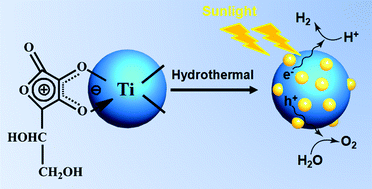Bidentate-complex-derived TiO2/carbon dot photocatalysts: in situ synthesis, versatile heterostructures, and enhanced H2 evolution†
Abstract
In this paper, we demonstrate a series of metal-free and inexpensive TiO2/carbon dot (CD) nanocomposites via facile hydrothermal synthesis from bidentate complexes of a green carbon source, vitamin C (VC). Other than the importance of deriving CDs from alternate carbon materials instead of graphitic precursors, the in situ transformed CDs from VC ensure the formation of chemically coupled heterostructures, TiO2/CDs, which serve as efficient photocatalysts exhibiting a higher H2 evolution rate from photocatalytic reactions up to 9.7 times than that of bare TiO2. Interestingly, the H2 evolution rate can effectively be tuned by VC amounts, hydrothermal temperatures and reaction durations. The mechanism of the enhanced H2 evolution rate was also discussed, in which the synergetic effects of the hydrothermal treatment along with the favourable electron transfer ability and upconverted photoluminescence of CDs contribute to the improved photocatalytic behaviour.


 Please wait while we load your content...
Please wait while we load your content...